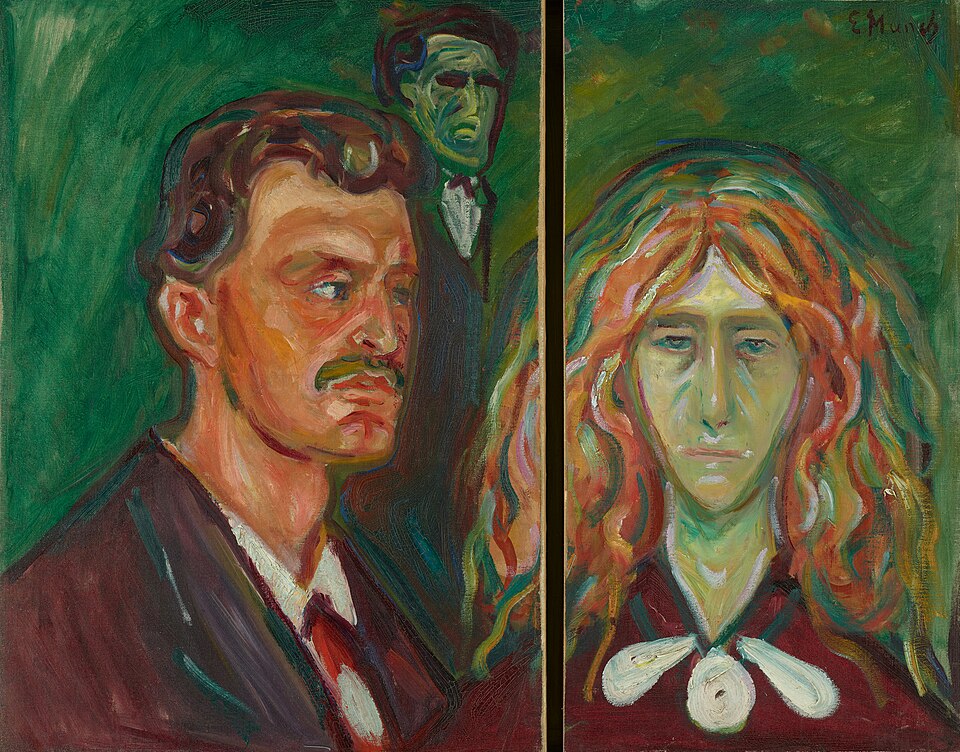
Edvard Munch, born on December 12, 1863, in Loten, Norway, was a prominent figure in the Symbolist and Expressionist movements. His childhood, marked by tragedy and illness, greatly influenced his artistic vision. Munch’s mother died of tuberculosis when he was just five years old, followed by the death of his older sister from the same disease. These early losses planted the seeds of melancholy that would later permeate his artwork.
Munch’s father, a deeply religious man, struggled to provide for his family. He instilled in young Edvard a fear of divine punishment and a sense of guilt, which later manifested in his work. Despite the hardships, Munch showed an early talent for drawing. Encouraged by his aunt, he enrolled in the Royal School of Art and Design in Kristiania (now Oslo) at the age of 17. This decision set him on a path toward becoming one of the most influential artists of his time.
As Munch developed his style, he began to explore themes of love, anxiety, and death. His works often reflected his own experiences and emotions. The use of bold colors and dramatic compositions became his signature style. However, as his career progressed, his personal life became increasingly complex, particularly his relationship with Tulla Larsen.
Tulla Larsen: A Complex Personality
Tulla Larsen was born in 1869 into a wealthy and influential family in Kristiania. She grew up in a privileged environment, enjoying the best education and cultural exposure that money could buy. Tulla was known for her beauty, charm, and intelligence. However, she was also described as headstrong and determined, often pursuing what she wanted with relentless persistence.
Tulla became fascinated with the bohemian lifestyle that was popular among artists and intellectuals of the time. She sought out the company of creative individuals, immersing herself in their world. It was during this period that she encountered Edvard Munch. Intrigued by his intense personality and dark, emotive paintings, Tulla was drawn to him in a way that would prove to be both passionate and destructive.
Their relationship was far from conventional. Tulla was deeply infatuated with Munch, but her feelings were not always reciprocated. Munch, who had a deep-seated fear of intimacy and commitment, was wary of her advances. Nevertheless, their lives became increasingly intertwined, leading to a tumultuous romance that would have lasting effects on both of them.
The Beginning of Their Relationship
Edvard Munch and Tulla Larsen met in the late 1890s. At the time, Munch was gaining recognition for his work, particularly his haunting painting The Scream, which had been completed in 1893. Tulla, captivated by Munch’s artistic genius, made it her mission to become part of his life. Despite Munch’s initial resistance, Tulla persisted, and eventually, the two became romantically involved.
Their relationship was intense from the start. Tulla was passionate and demanding, seeking to dominate Munch’s life in a way that often left him feeling trapped. Munch, on the other hand, was deeply conflicted. While he was attracted to Tulla, he also felt suffocated by her presence. His fear of losing his independence and being consumed by the relationship led to frequent arguments and periods of separation.
Despite these challenges, the two continued to see each other. Tulla believed that she could change Munch and make him more emotionally available, while Munch struggled with his own demons. His childhood experiences and the trauma of losing loved ones had left him emotionally scarred, making it difficult for him to fully commit to anyone.
The Breaking Point
As their relationship progressed, the tensions between Munch and Tulla escalated. Tulla’s desire to marry Munch became a source of constant conflict. She pressured him to settle down and start a family, but Munch was adamantly opposed to the idea. He feared that marriage would stifle his creativity and trap him in a conventional life that he desperately wanted to avoid.
Munch’s refusal to marry Tulla led to a series of heated arguments. Tulla, frustrated by Munch’s reluctance, became increasingly desperate. She threatened to leave him multiple times, hoping that her ultimatums would force him to change his mind. However, Munch remained steadfast in his decision, further straining their already fragile relationship.
The breaking point came in 1902 during a trip to Åsgårdstrand, a small coastal town in Norway where Munch often went to paint. During a particularly violent argument, Munch was accidentally shot in the hand, an event that would have profound consequences for both him and Tulla. This incident marked the beginning of the end of their relationship, as the physical and emotional scars from that day would never fully heal.
The Aftermath of the Shooting
The shooting incident in Åsgårdstrand was a turning point in Munch and Tulla’s relationship. The injury to Munch’s hand was severe, and although it eventually healed, it left a permanent scar both physically and emotionally. The event exacerbated Munch’s existing fears and anxieties, leading to a period of deep depression and increased alcohol consumption.
Tulla, who had hoped that the incident would bring them closer together, was devastated by Munch’s withdrawal. She had believed that she could save him from his inner turmoil, but instead, she found herself being pushed further away. Munch’s mental state deteriorated rapidly, and he became increasingly isolated from those around him.
The relationship between Munch and Tulla deteriorated beyond repair. Munch’s paranoia and distrust of Tulla grew, and he began to distance himself from her entirely. Despite her attempts to reconcile, Munch refused to see her, convinced that their relationship was toxic and destructive.
Eventually, Tulla gave up on trying to salvage their relationship. Heartbroken and disillusioned, she left Munch for good. The end of their relationship marked a significant turning point in both of their lives. For Munch, it led to a period of intense creative output, but also deeper psychological suffering.
Munch’s Struggles After the Breakup
After his breakup with Tulla Larsen, Edvard Munch’s mental health continued to decline. He struggled with alcoholism, depression, and anxiety, all of which were exacerbated by the traumatic events of his past. Munch’s art became a reflection of his inner turmoil, with themes of fear, death, and isolation becoming increasingly prominent in his work.
During this period, Munch painted some of his most famous works, including The Dance of Life and The Sick Child. These paintings, characterized by their haunting imagery and emotional intensity, captured the pain and suffering that Munch experienced in his personal life. His art became a form of catharsis, allowing him to express his deepest fears and anxieties in a way that words could not.
Despite his personal struggles, Munch’s reputation as an artist continued to grow. He gained recognition both in Norway and internationally, with exhibitions of his work being held in major cities across Europe. However, the pain of his failed relationship with Tulla lingered, casting a shadow over his life and work.
Munch’s health continued to decline throughout the 1900s. In 1908, he suffered a nervous breakdown and was admitted to a psychiatric clinic in Copenhagen. Although he eventually recovered and resumed painting, the scars from his relationship with Tulla and his subsequent struggles never fully healed.
Tulla Larsen’s Later Life
Tulla Larsen’s life after her relationship with Munch was also marked by tragedy and loss. After leaving Munch, Tulla married another man, but the marriage was short-lived and ended in divorce. Tulla’s obsession with Munch did not fade, and she remained fixated on him for many years.
In an attempt to move on with her life, Tulla traveled extensively, but she was never able to escape the shadow of her relationship with Munch. Her feelings of guilt and regret over how things had ended weighed heavily on her, leading to a life of loneliness and despair. Tulla never remarried and spent the remainder of her life in relative obscurity, away from the public eye.
Tulla died in 1942, at the age of 73. Although she had once been a vibrant and passionate woman, her life was ultimately defined by her ill-fated relationship with Edvard Munch. The love she had once felt for him turned into a source of pain and sorrow that she was never able to fully overcome.
Tulla’s relationship with Munch was a tragic chapter in both of their lives, one that left deep scars on both of them. Although they went their separate ways, the impact of their relationship continued to be felt for many years after it ended.
The Impact on Munch’s Art
The relationship between Edvard Munch and Tulla Larsen had a profound impact on Munch’s art. The emotional intensity and psychological depth that characterized his work during and after their relationship were inextricably linked to the pain and suffering he experienced. Munch’s art became a reflection of his inner world, with his experiences with Tulla serving as a catalyst for some of his most powerful and enduring works.
Munch’s The Dance of Life, painted in 1899–1900, is often interpreted as a representation of his relationship with Tulla. The painting depicts a woman in three stages of life: youth, adulthood, and old age. The central figure, a woman in a red dress, is often seen as a symbol of Tulla, while the two figures on either side represent different aspects of Munch’s feelings towards her. The painting captures the complexity of their relationship, with its mix of love, desire, fear, and despair.
Another significant work, Ashes (1894), depicts a couple in a desolate landscape, with the woman’s face turned away in despair while the man stands with his head in his hands. The painting is often seen as a metaphor for the breakdown of their relationship, with the ashes symbolizing the remnants of their love. The dark and foreboding atmosphere of the painting reflects the emotional devastation that Munch felt as his relationship with Tulla unraveled.
The influence of Munch’s relationship with Tulla can also be seen in his later works. His experiences with love, loss, and mental illness continued to shape his art until the end of his life. Munch’s ability to convey the depth of human emotion through his art has made him one of the most celebrated and influential artists of the 20th century.
Conclusion: A Tragic Love Story
The relationship between Edvard Munch and Tulla Larsen is a tragic love story that left an indelible mark on both of their lives. For Munch, the relationship was a source of inspiration, pain, and ultimately, artistic growth. His experiences with Tulla fueled some of his most iconic works, allowing him to explore the depths of human emotion in a way that few artists have ever achieved.
For Tulla, the relationship was a source of obsession, heartbreak, and regret. Her love for Munch, though genuine, was ultimately unrequited, leading to a life of loneliness and sorrow. The intensity of their relationship, combined with the deep psychological wounds that both carried, created a volatile and ultimately destructive dynamic that neither could escape.
In the end, the relationship between Edvard Munch and Tulla Larsen serves as a reminder of the complexities of love and the ways in which our deepest relationships can shape our lives and our art. Their story is one of passion, pain, and the enduring power of human emotion, captured forever in the haunting and evocative works of Edvard Munch.




